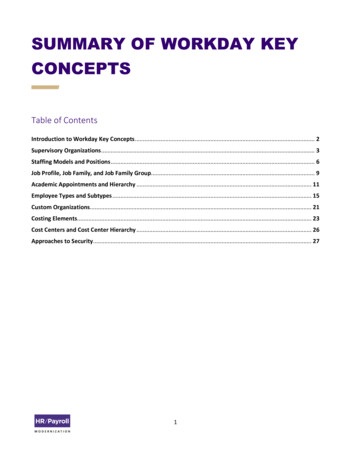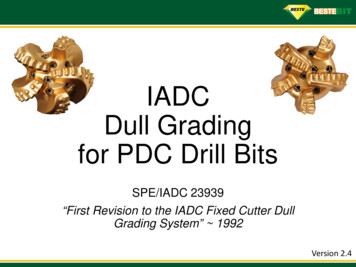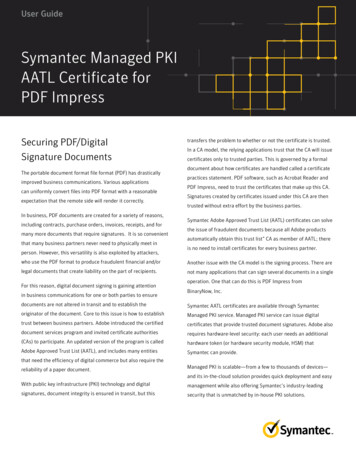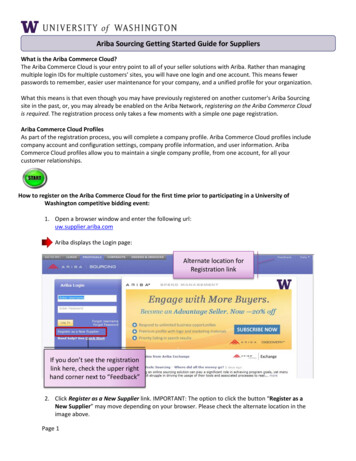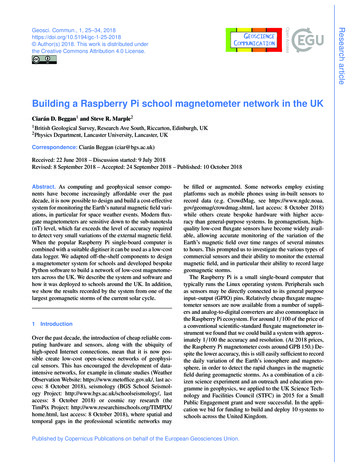
Transcription
2014 MAGNET PROFILES SSe pect ciaio lnRecognizing Nursing Excellence
P ROFILESMMAGNETAGNETStructural empowerment andthe Magnet Model: A perfect fit Are empowerment structures present in your workplace?By Shelley Moore, PhD, MSN, RNNursing literature abounds with descriptiveand predictive studies of structural empowerment and its relationship to nurses’ trust,commitment, control over practice, intent to stay,productivity, job satisfaction, engagement, andquality of care. This article explores the links between the Magnet Model and structural empowerment in the workplaceStructural empowerment is one of the fivecomponents of the Magnet Model. Theothers are transformational leadership; exemplary professional practice; newknowledge, innovations, and improvements; and empirical outcomes.Within the context of the Magnet Model, structural empowerment encompasses organizationalstructure, personnelpolicies and programs, professionaldevelopment, community outreach, andpromotion of a positivenursing image. How do these elements reflect structural empowerment? Here are a few examples: Establishing a “just culture” supports professional accountability anderror reporting in an effort to improvepatient safety rather than punish or ostracize people for their mistakes. Creation of a peer-review council allows those“in the know” to conduct performance evaluation, not those far removed from the work. The shared governance philosophy plays out indecision-making policies.Through transformational leadership, organizational structure, transparency, congruence ofmission with day-to-day operations, and the workenvironment, a healthcare organization is either“magnetized” or not. Today’s healthcare leadersare expected not just to empower staff, solveproblems, and adapt to change. To truly embracehealthcare reform in creative ways, they alsomust foster a certain degree of controlled destabilization that births new ideas and innovations.People (not only staff but also patients and families) should feel comfortable asking questions.A structurally empowered nurse is best equippedto protect patients’ rights. A Magnet organizationfocuses not just on improving its own performancebut also on contributing new knowledge to the science of nursing. It’s expected to use the latest research-based evidence in all of its practices.Exemplary professional practice in aMagnet organization transcends theorganization itself and extends to thepractice of nursing as a whole. Oneway to transcend the organization is through communityoutreach. A strong professional nursing practice in aMagnet organization should bepalpable in thecommunity. Anempowered nursewho’s involved incommittees andtask forces that influence change in the hospital also may serve on community boards. In this way,she or he leaves a nursing imprint on healthcare policies outsidethe hospital. When hospital leaderssupport this nurse’s community involvement, they’re demonstrating structural empowerment.Even a nurse who works in one of the most restricted hospital settings—the perioperativearea—can project a positive image of nursing inthe community. For instance, she may volunteerto provide surgical care for people in need locally,regionally, nationally, or even globally. Or shemay serve as the hospital’s laser safety officer,seeking input from nurses and other staff whowork with surgical lasers and interfacing withlaser industry representatives while keeping patients’ best interests in mind. In this role, she’sdemonstrating the value of patient advocacy totechnical, research and development, and mar-Structuralempowerment46American Nurse TodayVolume 9, Number 9(continued on page 48)www.AmericanNurseToday.com
Hackensack University Medical Center hasMagnet designation indicates not only ouralways been proud of its exceptional nursingcommitment to quality patient care, butand patient care team. We congratulate ouralso affirms the supportive environment weteam of more than 1,900 nurses for achievingprovide our nurses to encourage innovationour fifth consecutive Magnet designation —and professional growth.marking our 20th year as a Magnet hospital.We are grateful for the countless contributionsHackensackUMC is just one of two hospitalsof our world-class nursing team. Together within the entire nation to achieve this feat — thethe rest of our HackensackUMC team, theyhighest honor that can be bestowed by thecontinue to go beyond for our patients.American Nurses Credentialing Center.HackensackUMC.org 855.996.WELL (9355)University Health NetworkHackensack UniversityMedical CenterHackensack UniversityMedical GroupHackensackUMCMountainsideHackensackUMCat Pascack ValleyPalisadesMedical CenterMAGNET PROFILESOUR NURSESGO BEYOND ONCE AGAIN.
MAGNET PROFILES(continued from page 46)keting professionals. Thus, she promotes an understanding of what nurses do first and foremost—preserve patient safety.Factors that promote structural empowermentFirst described in 1977, the theory of structuralempowerment posits that certainfactors in a work environmentcan enable or block employees’ability to accomplish their workin meaningful ways. The fourempowerment structures are: access to resources needed forone’s work access to information neededto get one’s job done as well asknowledge and understandingof the organization support for one’s responsibilities and job performance opportunity for professional growth and development.Having formal and informal power enhancesthese factors.Do you have opportunities to use all of yourskills and knowledge? Do you believe yourworkplace is an empowering environmentoverall? (Note: These questions come from theConditions of Work Effectiveness Questionnaire, which measures structural empowerment within the work setting.)If you answered no to someof these questions, it doesn’tnecessarily mean you work ina negative organization—justthat there’s room for growthand a need for change. Youmay be able to change somethings yourself. For example,perhaps access to informationis present but you’re not taking advantage of it. Maybeyour supervisor has givenyou recommendations butyou haven’t heeded them. Onthe other hand, perhaps the leadership mindsetat your organization needs to be transformed.Being candid with your employer about your perceptions may lead to strategies to improve theenvironment.Cultivating an exceptional work environmentdoesn’t happen overnight. To use a term that occurs throughout Magnet literature, this truly is ajourney. Be patient, be engaged, and get involvedin the improvement process to maximize strucntural empowerment in your workplace.Perhaps access toinformation ispresent but you’renot takingadvantage of it.How does your workplace stack up?Consider whether the empowerment structures described above are present in your workplace. Does your environment help you accomplishyour work in meaningful ways? Do you haveaccess to the resources needed for your work?Do you have the time and appropriate resources with which to accomplish your work? Do you have access to the information youneed to get the job done? Do you know thevalues and goals of your hospital’s leaders?Are you aware of its financial status? Do youknow the future direction leaders want to takethe hospital? Do you feel your manager supports your responsibilities and job performance? Does yourmanager provide specific information abouttasks you do well? Does he or she give youtangible recommendations on how you canimprove? Do you believe your work is valued?What about rewards for contributing innovative ideas and showing flexibility in your job? Is your work visible within the organization asa whole? Do you work collaboratively withphysicians and other healthcare team members? Do they work collaboratively with you?Do peers and managers seek your help withproblems? Does your employer give you former presidents, whoPPC structureserve as advisors to their organizations.The PPC structure is relatively simple. All nursesAt Rush, we incorporated the American Associwho’ve served as PNS president at Rush are ofation of Critical-Care Nurses’ Standards for Estabfered lifetime memberships on the council, inlishing and Sustaining Healthy Work Environcluding those no longer employed at Rush. Curments (2005) into the guiding values of the PPC.rently, the PPC has two highly engaged Rush pastSpecifically, we incorporated the standards of truepresidents who now work in other organizations.collaboration and authentic leadership.The PPC allows these leaders to stay connected to True collaboration means every team memberthe council while letting us benefit from their exembraces collaboration as an ongoing processperiences in other nursing roles. Also, the currentand invests in its development to ensure a susPNS president and president-elect, as well as thetained culture of collaboration.president of the nursing SG organization at our Authentic leadership holds that nurse leaderssister hospital, Rush Oak Park Hospital, are PPCmust demonstrate skilled communication, truemembers. (See Where are they now?)collaboration, effective decision-making, andKathy Pischke-Winn, 1989-1990 PNS president,meaningful recognition.stated, “I take pride in being a member of theAt Rush, we believed the PPC could help inculRush PPC. In my role as Magnet Program Directorcate these values in our emerging SG leaders.at University of Chicago Medicine [UCM], I appreciate having a network of strong shared goverPPC goalsnance leaders and friends. Last year, I reached outOverall PPC goals are for members to serve as adto the PPC and they helped organize speakers forvisors to PNS officers, mentor current and futurea shared governance retreat for an audience ofUCM staff nurses and unit managers. I knew IPNS leaders, engage in leadership successioncould rely on this group to share their expertise inplanning, and support the growth and susteshared governance.”nance of our SG organization. A past presidentchairs the PPC, assuming responsibility for coordinating meetings, driving outcomes, and providing Institutional memoryreports to the PNS. The group meets monthly; theHistory often repeats itself, even in an SG strucPNS president and PPC chair set meeting agenture. The past presidents are a great source of indas. Most of the meeting time is dedicated to PNSstitutional memory for current PNS leaders atoperations and professional practice matters.Rush. The PPC has consulted on such topics as52American Nurse TodayVolume 9, Number 9www.AmericanNurseToday.com
past presidents on current issues we face has afforded menot only years of experiencefrom their tenure and howthey overcame similar challenges, but access to an amazing collection of wisdomshared by these thought leaders to help us problem-solve.”Whether your organizationis in the planning or development stages of SG, considerthe value of creating a formal mentoring structure forcurrent and future leaders ofyour SG organization. In our organization, thePPC has affected our leaders’ growth and development, along with their leadership trajectory innnursing and health care.The past presidentsare a great sourceof institutionalmemory for currentPNS leaders.Selected referenceMentoring current leadersThe PPC supports leadership development of thePNS president and president-elect. The role of PNSpresident at Rush can be daunting, and newlyelected nurse leaders need support to make an effective transition from the bedside to the boardroom. Dr. Eric Zack, current PNS president, states,“Having a consistent opportunity to engage withWhere you work matters.The nurses at Morristown Medical Center are the heart and soul ofthis institution. Their compassion, dedication and demonstrated focus onevidence-based care and research ensures continued leadership in thedelivery of quality healthcare to our clientsMagnet designation is the highest honora hospital can attain for nursing. MorristownMedical Center has been designated by the ANCCas a Magnet hospital four consecutive times. Weare proud of our staff and their accomplishmentswhich led us to achieve this honor.We seek to recruit and retain dedicated, high-quality nurses. We createpathways that motivate and inspire their career development andprofessional advancement. From helping patients live healthier lives todayto developing new solutions that will help thousands in the future, ournurses bring outstanding care to our community, our state, and beyond.American Association of Critical-Care Nurses. AACN Standards for establishing and sustaining healthy work environments: a journey to excellence. 2005. www.aacn.org/WD/HWE/Docs/HWEStandards.pdf. Accessed July 2, 2014.Three of the authors work at Rush University in Chicago, Illinois: Cathy Catrambone is an associate professor at the College of Nursing, Elizabeth Myers is arisk manager, and Jessica Walker is a staff nurse. Benson Wright is a patientclassification consultant at API Healthcare in Chicago.Transforming Care andTransforming LivesChildren’s Mercy nurses are more than just outstandingprofessionals and caregivers. Our nurses are innovatorsand leaders who are helping improve care and change howpediatric nursing is practiced here and around the world.Our commitment to education and training has led to havingmore advanced practice, specialty certified, and BSN preparednurses than any other hospital in the region. Here, nurses areleaders in quality improvement initiatives and research that aretransforming care and transforming lives.Join us in transforming lives at www.childrensmercy.org/nursingIf you want to work in an environment where everyonelearns together, where collaborative interdisciplinarycare is at the heart of everything we do, and wherenurses are treated as knowledgeable equals,Children’s Mercy is where you want to be.Gayla Huffman, RN, BSN, CPNEducation Coordinator5 Sutherlandjobs.atlantichealth.orgWe are an Equal Opportunity Employer. All qualified applicants will receive consideration for employment without regard torace, color, religion, sex, national origin, disability or protected veteran status.Magnet is a registered trademark of the American Nurses Credentialing Center.FORTUNE and FORTUNE 100 Best Companies to Work For are registered trademarks of Time Inc. and are used underlicense. From FORTUNE Magazine, February 3, 2014 2014 Time Inc. FORTUNE and Time Inc. are not affi liated with, anddo not endorse products or services of, Licensee.www.AmericanNurseToday.comSeptember 2014American Nurse Today53MAGNET PROFILESbylaw revisions and interpretation, peer-review process,code of conduct, appeals ofdisciplinary action, and denials of advancement on theclinical ladder. Past presidents share examples of howthey handled these situationsand support the current president and president-elect. ErikMcIntosh, 2011-2012 PNSpresident, recalls, “Duringmy term as president, questions arose about the reporting structure of the PNS inthe hospital’s quality plan. I was able to consultwith the PPC and gather historical information tobring to leadership and build a case for ourshared governance organization to report to theboard of trustees, just like our medical staff does.”
MAGNET PROFILESMAGNET NURSESINAC TIONCalming the chaos: Simulatedcode interdisciplinary teamtrainingSimulation prepares caregivers for the intensity of criticalevents.By Cynthia Perez, MS, RN, CNS, CCRNAs a healthcare professional, you’ve probablywitnessed the chaos and confusion that ensue when a “code blue” is called for a patient in cardiac arrest. This emergency requires anurgent, organized response with immediate coordination of members of a highly capable interdisciplinary emergency resuscitation team.At Oregon Health & Science University (OHSU),a Magnet hospital, the code blueteam may consist of staff who’venever worked together before. Its sixmembers include a physician teamleader (a medical intensive careunit [ICU] fellow), an anesthesiologist, a respiratory therapist, andthree critical care nurses. All teammembers except the respiratorytherapist are certified in advancedcardiac life support (ACLS). OHSUpolicy defines the roles of eachteam member.In 2008, nurse code-blue responders identified the need for additional training to improve patientsafety and enhance code-respondernurses’ confidence and performance. The code RN developmentprogram was created in collaboration with the adult rapid response team and thesimulation center. Through this training, staffidentified the need for more clearly defined roles.The nurses identified three primary nursing responsibilities (called the 3D roles) that must be addressed in a code blue event—drugs, defibrillator,and documentation.Enter SCITTIn 2009, OHSU recognized this innovative trainingand, understanding the need for high-stakes teamsto train together, asked that the training becomeinterdisciplinary. Consistent with Magnet princi54American Nurse TodayVolume 9, Number 9ples, OHSU nurses often assume leadership rolesin collaborative interprofessional activities to improve the quality of care, so this project fit in wellwith the organization’s culture.With support from hospital administrators, aninterdisciplinary committee was formed andcochaired by a nurse and physician. Committeemembers (physicians, nurses, respiratory thera-pists, and quality management and simulationspecialists) developed a program of mock codescalled simulated code interdisciplinary team training (SCITT). SCITT was officially launched in August 2009 for the purpose of training high-performing teams using crew resource management(CRM) strategies and ACLS algorithms to managecomplex and dynamic crisis situations.Evidence supports using simulations for cardiacresuscita
Mountainside HackensackUMC at Pascack Valley . Walker KN, Duff J, Di Staso R, et al. Perioperative nursing shines! Mag - net designation reflected in staff engagement, empowerment and ex - cellence. Acorn: J Periop Nurs Austr. 2011;24(3):34-42. Sh el yMo r isa n tp f d T U v School of Nursing in Murfreesboro. P erhaps access to



